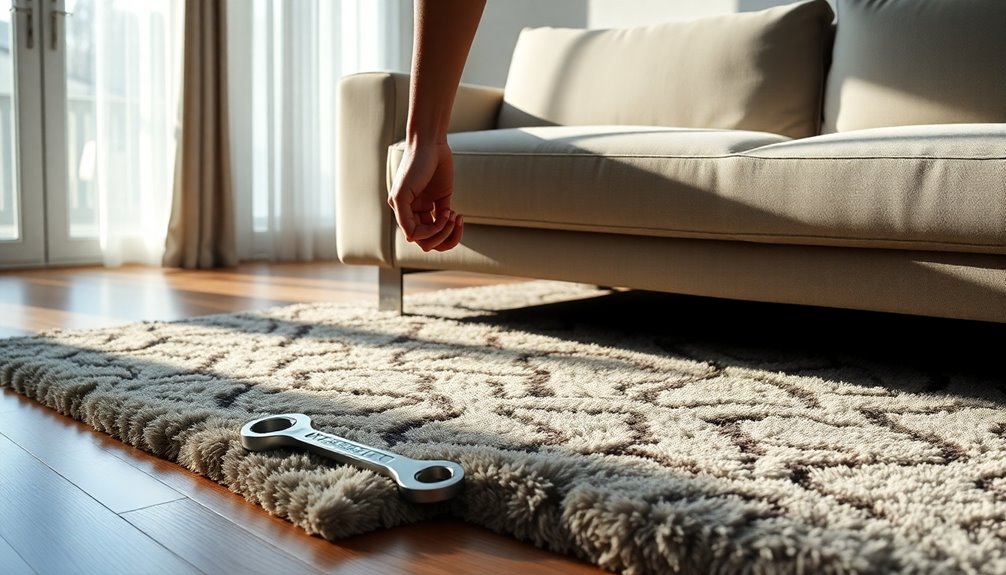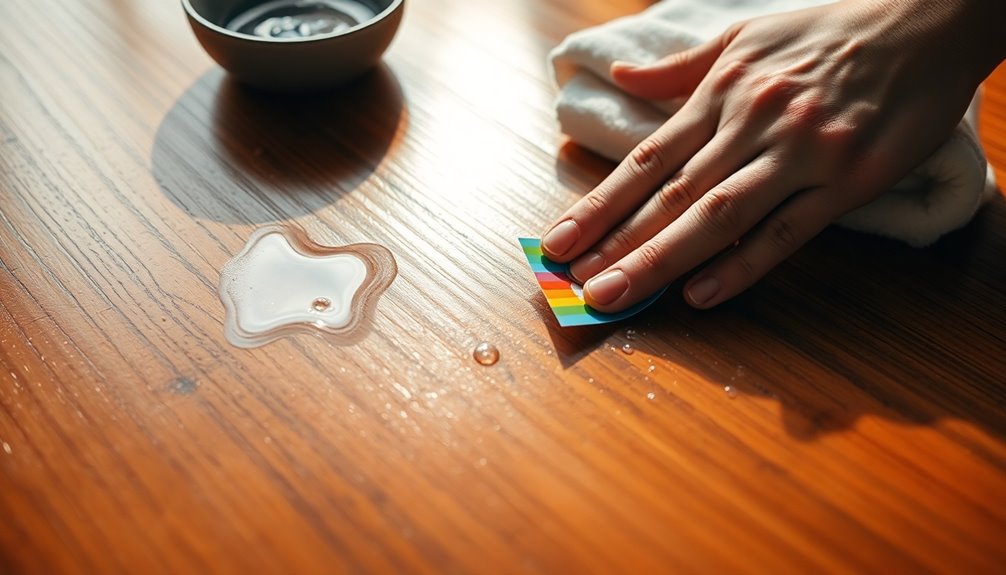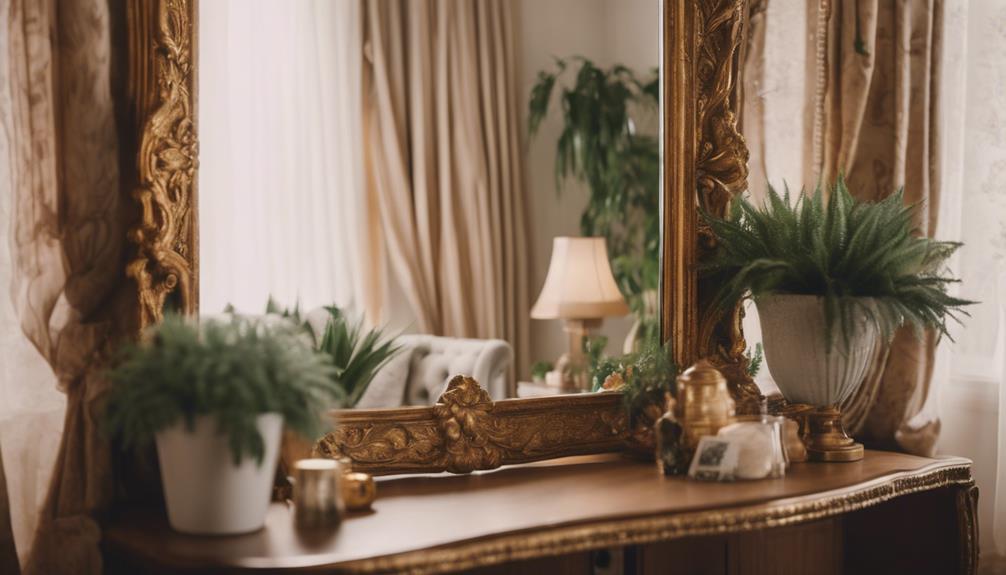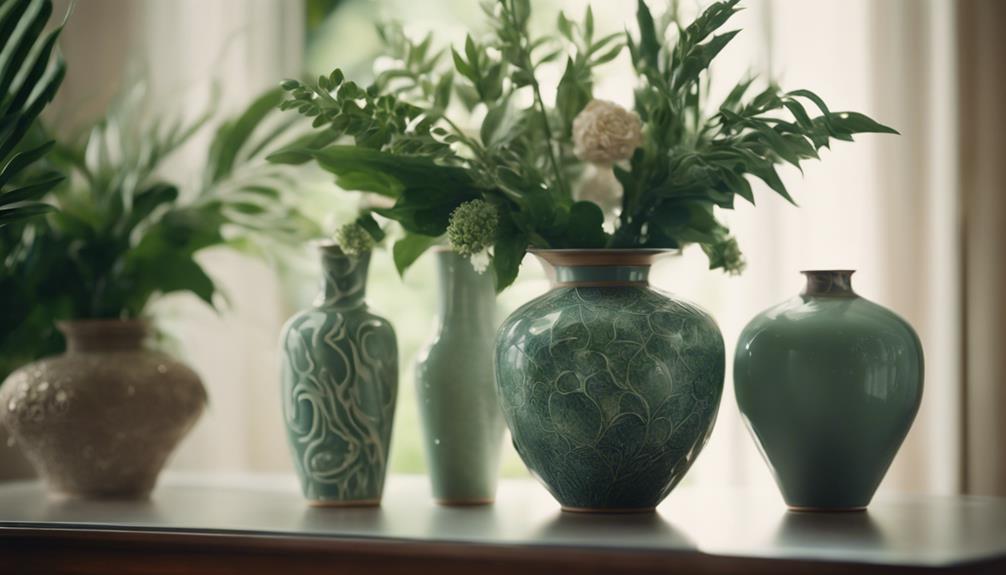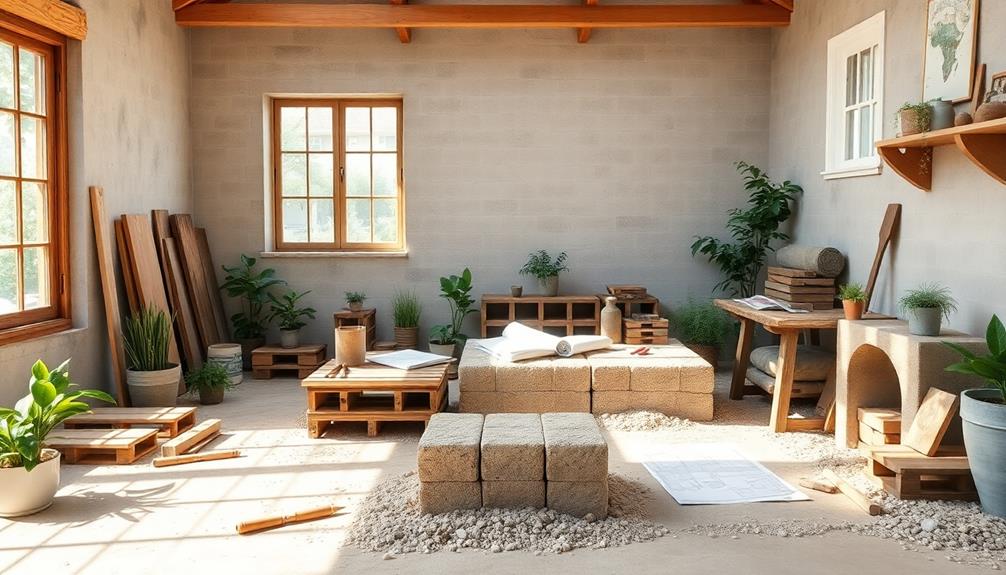To disconnect a sofa, begin by checking for any modular pieces or fasteners that keep the sections secured. Look for zippers, velcro straps, or screws. Gently unfasten these components, taking care not to force anything, as it might cause damage. If the sofa has attached cushions, remove them first to make disassembly easier. Once everything's detached, label each piece for easier reassembly later. Keep in mind that regular maintenance, like checking upholstery, can prolong your sofa's life. Stick around to discover more tips on efficient sofa care and storage.
Key Takeaways
- Check for any hidden fasteners or connectors that may secure the sofa sections together before attempting to disconnect them.
- Gently pull apart the sections while applying steady pressure; avoid jerking to prevent damage to the upholstery or frame.
- If applicable, locate and unfasten any zipper or velcro attachments on removable covers to separate the sections easily.
- Use a helper to assist in disconnecting larger sofas, ensuring both sides are handled simultaneously to prevent imbalance.
- After disassembly, store parts in a climate-controlled environment to maintain integrity and prevent damage during storage.
Introduction
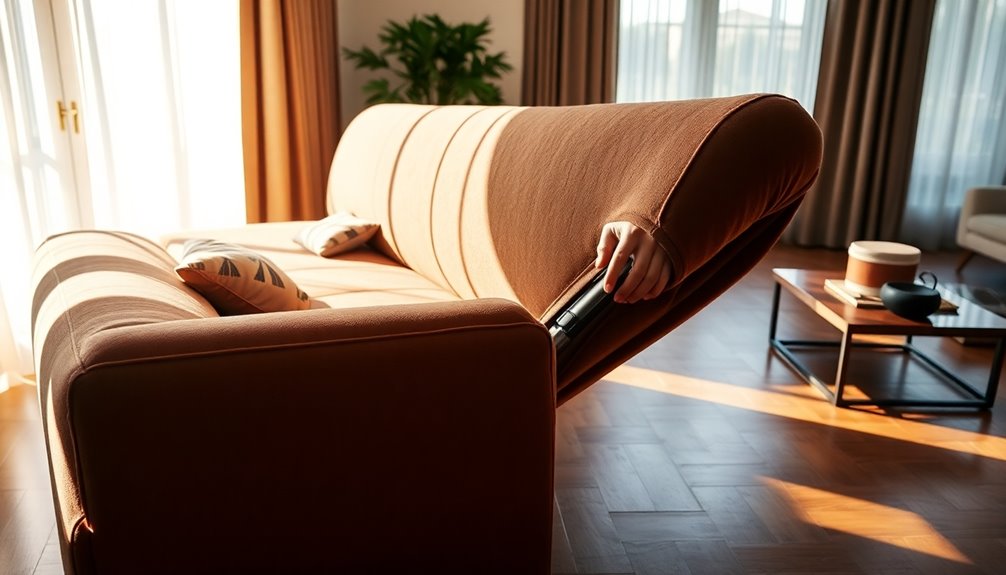
Keeping your sofa in great shape starts with regular fabric inspections and knowing the right cleaning techniques for its material. You'll also want to tackle those pesky stains, like wine and ink, before they set in. By staying proactive, you can ensure your sofa remains a stylish and comfortable centerpiece in your home.
Routine Fabric Inspection
To maintain your sofa's beauty and longevity, it's crucial to keep an eye on its fabric. Regular inspections can help you catch signs of wear, like fraying, discoloration, or small tears, before they get worse. For sectional sofas, which often see more use, pay close attention to all sections, especially where pieces connect.
Use a flashlight during your inspection to spot hidden stains or damage that might not be visible in regular lighting. Don't forget to check the seams and stitching, as these areas often reveal the first signs of stress or damage. If you notice any issues, addressing them early can save you from costly repairs down the line.
Additionally, follow the manufacturer's cleaning guidelines to maintain your fabric's appearance and prevent dirt and allergens from building up. Scheduling routine inspections every six months will keep your high-quality sofa in optimal condition and significantly extend its lifespan. By staying proactive, you'll not only enhance the look of your sofa but also enjoy its comfort and functionality for years to come.
Fabric-Specific Cleaning Techniques
How can you ensure your sofa stays looking fresh and clean? Understanding fabric-specific cleaning techniques is essential for maintaining your sectional sofa. If your sofa's upholstery is cotton, mix mild detergent with water. Apply this solution with a soft cloth, gently blotting to avoid saturating the fabric. For polyester, a combination of water and vinegar works wonders; use a soft brush to scrub away any stains without damaging the fibers.
Microfiber sofas require a different approach. Mix isopropyl alcohol with water, applying it with a clean cloth to lift stains effectively. Allow the fabric to dry to restore its texture. If you have a velvet sofa, take a gentle approach. Use a vacuum with a brush attachment to remove dust, and for deeper cleaning, a steam cleaner is your best bet—just ensure you don't damage the fabric.
Always remember to check the manufacturer's cleaning code labels on your fabric sofas. This will guide you in choosing the safest cleaning techniques and products tailored to your specific material. Following these steps will keep your sectional sofa looking its best for years to come! Additionally, maintaining a clean environment around your sofa can help prevent dust and allergens from accumulating, enhancing your overall indoor air quality.
Tackling Wine and Ink Stains
Stains can be a nightmare for any sofa owner, especially when it comes to wine and ink. The key to effective cleaning is to act quickly. For wine stains, grab a clean cloth and immediately blot the area to absorb the excess liquid. Don't rub; that'll only spread the stain further.
When it comes to ink stains, use rubbing alcohol or hand sanitizer. Apply it to a cotton ball and gently dab the stain. The alcohol helps break down the ink while being gentle on the fabric. Always remember to test any cleaning solution on a hidden part of the sofa first to avoid discoloration or damage.
After treating the stains, rinse the area with cold water and blot it dry to remove any leftover cleaning solution. This step is crucial to prevent residue build-up that could attract more dirt. If you find the stains stubborn, don't hesitate to reach out to professional cleaning services. They have specialized equipment and solutions to ensure your upholstery looks its best again. By tackling wine and ink stains promptly and effectively, you can keep your sofa looking fresh and clean.
Avoiding Direct Sunlight
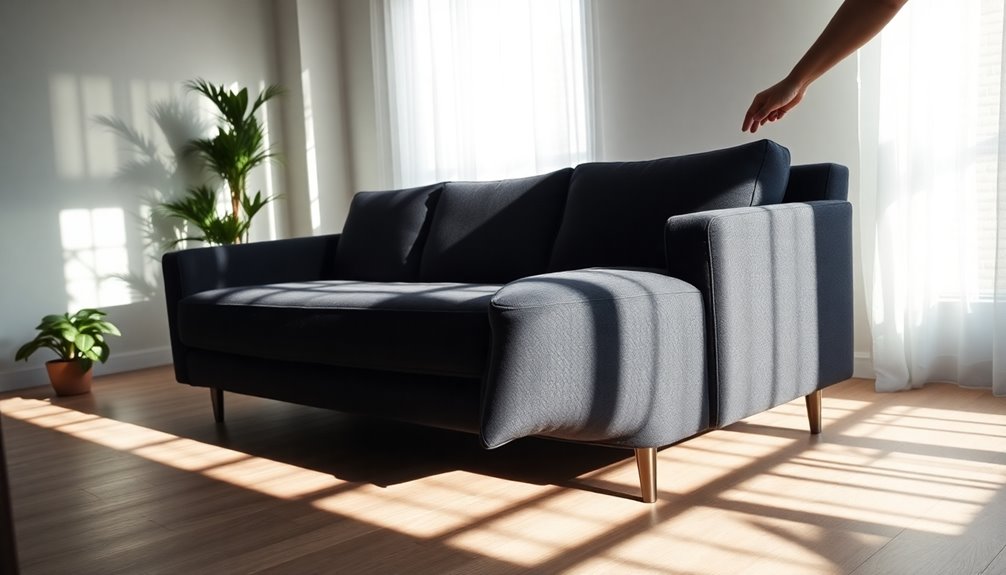
To keep your sofa looking great, you need to avoid direct sunlight. Choosing durable upholstery materials can help resist fading, while adding decorative fabrics offers extra protection. Don't forget to regularly rotate cushions to maintain an even appearance and prolong their life.
Choosing Durable Upholstery Materials
Choosing the right upholstery materials for your sofa is crucial if you want to keep it looking great for years. When selecting fabrics for your sectional, opt for those with high UV resistance to prevent fading from direct sunlight. Fabrics like solution-dyed acrylic or polyester are excellent choices, as they offer durability and colorfastness. Natural fibers such as cotton and linen may look appealing, but they can be prone to sun damage.
Look for upholstery rated with a minimum of 300 hours of lightfastness, ensuring your sofa maintains its original color longer. If you want to extend the life of your upholstery further, consider adding window treatments like shades or curtains to block direct sunlight. This simple addition can make a significant difference in preventing fading.
Also, make it a habit to regularly rotate and fluff your cushions. This practice promotes even wear and helps minimize sun exposure on specific areas, keeping your sectional looking fresh. By choosing the right materials and taking some protective measures, you can enjoy a beautiful and lasting sofa for years to come.
Protecting With Decorative Fabrics
A well-placed decorative fabric can be your sofa's best defense against the damaging effects of direct sunlight. By using slipcovers or throws, you can effectively shield your sofa from harmful rays that cause fading and damage. Opt for fabrics with UV-resistant treatments, which will enhance your upholstery's longevity by blocking those degrading rays.
Positioning your sofa away from windows is another smart move. If that's not possible, consider adding sheer curtains to reduce sunlight exposure while still allowing natural light to brighten your space. Additionally, using decorative fabrics can help distribute sunlight exposure evenly, minimizing the risk of uneven fading.
Don't forget about furniture sprays that offer UV protection, adding an extra layer of defense against sun damage on your fabrics. Regularly changing out your decorative items can further help in protecting your sofa, as it keeps the fabric from being constantly exposed to sunlight.
Regularly Rotate Cushions
While it might seem minor, regularly rotating your sofa cushions is essential for maintaining their shape and comfort. By rotating cushions every 1-2 weeks, you help distribute wear evenly, which prevents indentations and sagging in high-use areas. This simple practice prolongs the lifespan of your sofa and keeps the pieces looking fresher for longer.
If your sofa has fixed cushions, consider flipping them if possible. This can help combat uneven wear and keep them in good shape. To ensure you never forget to rotate cushions, set a schedule that allows all areas to receive equal attention. Consistency is key!
Additionally, be mindful of where you place your sofa. Avoid putting it in direct sunlight, as prolonged exposure can lead to fading and deterioration of the fabric or leather. By keeping your cushions away from harsh sunlight, you can maintain their color and integrity over time.
Incorporating these habits into your care routine will not only enhance your sofa's aesthetic appeal but also improve your overall comfort. So, make it a point to regularly rotate your cushions and protect your investment!
Upholstery Stitching Checks
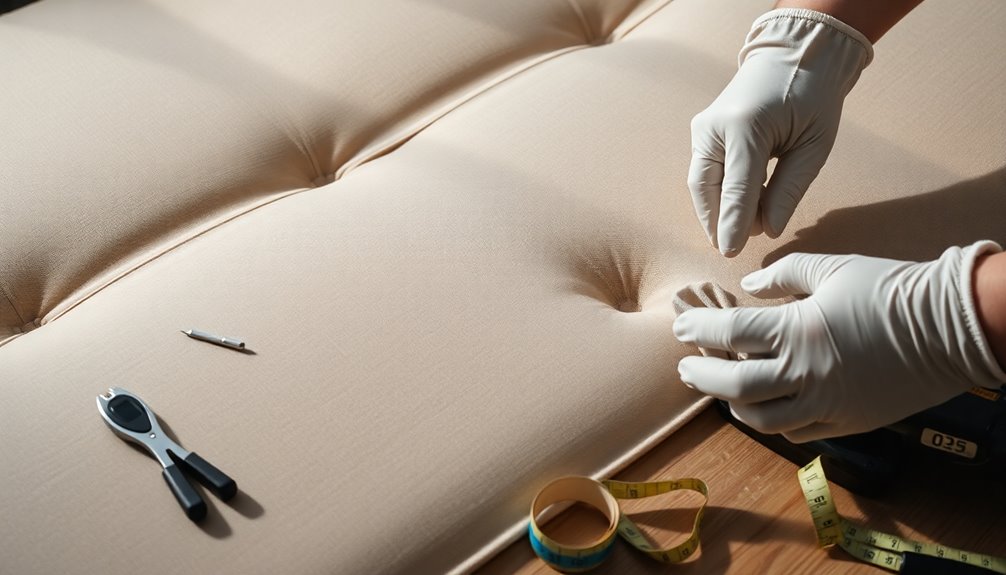
When checking your upholstery stitching, don't overlook how it affects the overall stability of your sofa frame. You'll also want to consider leather conditioning techniques to keep your fabric in top shape. Plus, regularly fluffing the cushions can help maintain their support and comfort, ensuring your sofa lasts longer.
Frame Stability Concerns
To ensure your sofa remains stable and comfortable, regularly checking the upholstery stitching is crucial. Inspect the stitching for any signs of fraying or unraveling, as these issues can directly impact the frame stability. Loose threads can weaken the connection between the upholstery and the frame, so reinforce any weak spots you find.
Pay special attention to the seams, particularly in areas where stress is applied. These high-wear spots may need additional reinforcement to prevent further damage. If your sofa has removable covers, make sure the zippers and velcro attachments function properly. This prevents fabric from shifting, which can also affect frame stability.
If you notice significant stitching issues, don't hesitate to consult a professional. Timely repairs can save you from more extensive damage to both the upholstery and the frame. By keeping everything in one piece and addressing these concerns promptly, you can maintain the overall strength and integrity of your sofa. Regular checks will help keep your sofa looking great and provide the comfort you expect, ensuring that it serves you well for years to come.
Leather Conditioning Techniques
Maintaining the integrity of your leather sofa goes beyond checking upholstery stitching; it also involves proper conditioning techniques. Regularly inspect the stitching to catch any loose or fraying threads that could lead to further damage. To keep your leather supple and looking great, use a high-quality leather conditioner every 6-12 months. This not only enhances the appearance but also helps prevent the stitching from becoming brittle over time.
When applying the conditioner, make sure to do so evenly across one side of the sofa at a time, avoiding over-saturation. Too much moisture can weaken the stitching and may lead to separation, which you definitely want to avoid. If you notice minor stitching issues, a leather repair kit can be an excellent solution for addressing these small problems before they escalate.
Always follow the manufacturer's instructions for cleaning and conditioning your leather. This ensures compatibility and effectiveness, safeguarding the integrity of your upholstery stitching. By being proactive with these leather conditioning techniques, you'll extend the life of your sofa and maintain its luxurious appeal.
Cushion Fluffing Techniques
Although you might not think about it often, regularly fluffing your sofa cushions is essential for keeping them in great shape. This simple task helps maintain their shape and comfort, preventing flattening and extending the lifespan of your upholstery. Start by using a vacuum with an upholstery attachment to clean your cushions before fluffing, removing dust and debris that can affect fabric integrity.
Next, check the upholstery stitching for any loose threads or fraying. Addressing these issues early can prevent further damage and keep your sofa looking its best. When fluffing, rotate and flip your cushions and sectional pieces periodically to ensure even wear and prevent one side from becoming compressed.
After fluffing, consider using a fabric refresher or spray designed for upholstery to enhance not just the appearance but also the fragrance of your sofa. By incorporating these cushion fluffing techniques into your regular maintenance routine, you'll keep your living space inviting and prolong the life of your furniture. Remember, a little care goes a long way in preserving the comfort and aesthetics of your sofa!
Custom Cushion Sizes
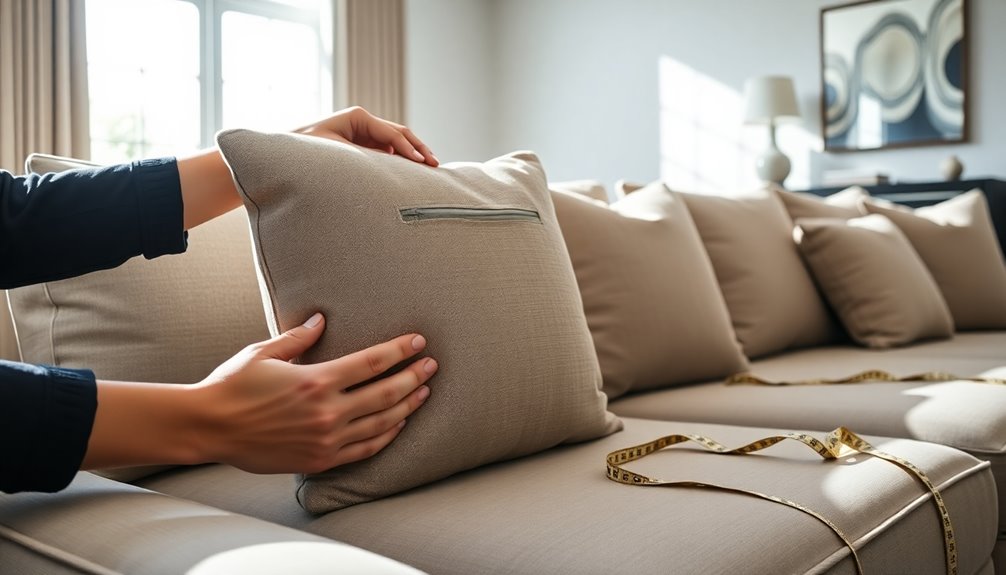
When it comes to custom cushion sizes, achieving the perfect fit for your sectional sofa is essential for both aesthetics and comfort. Custom cushions are designed to match your unique sectional configuration, ensuring a seamless look that enhances your living space. To order custom cushions, start by measuring the existing ones—length, width, and thickness are all crucial for accurate sizing.
You can choose from various filling options, like foam, down, or polyester, each affecting the feel and support of the cushions. Additionally, custom cushions can be tailored in different shapes to match your sectional design, whether it's square, rectangular, or L-shaped.
Many manufacturers provide fabric swatches, allowing you to select materials that complement your decor. This ensures that your cushions not only fit perfectly but also stand up to daily wear and tear while being easy to clean.
Seasonal Storage Strategies
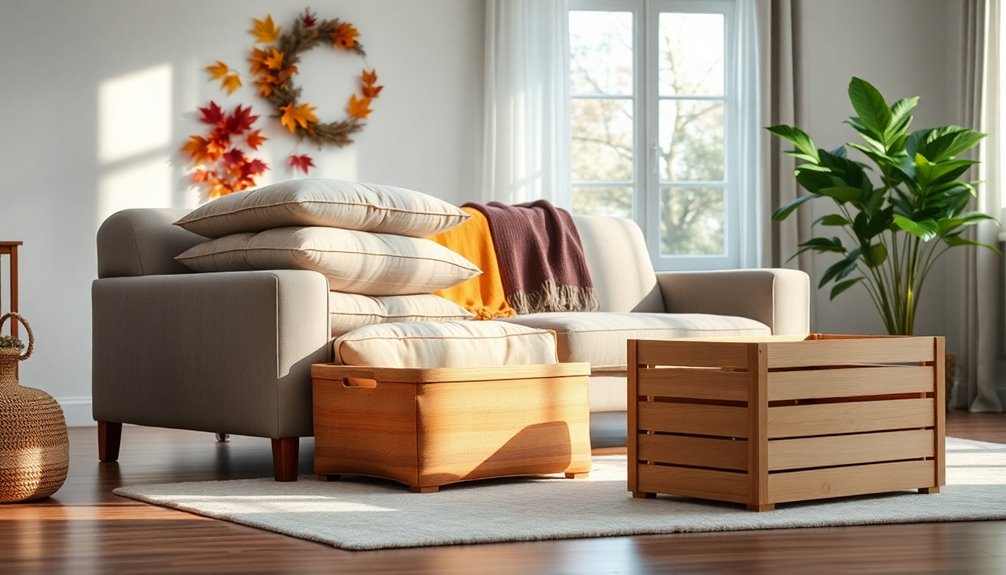
Seasonal storage requires careful planning to ensure your sectional sofa stays in top condition. Start by thoroughly cleaning the sofa according to the manufacturer's instructions, as this will prevent stains and damage while it's stored. Next, disassemble the sofa into manageable pieces. As you do this, carefully label each part and store screws and connectors in labeled bags to make reassembly a breeze later.
Once disassembled, use breathable furniture covers or blankets to protect the fabric from dust, moisture, and pests. This step is crucial for maintaining the quality of your sofa. Store it in a climate-controlled environment, avoiding areas with extreme temperature fluctuations or high humidity to keep the materials intact.
To further protect your sectional, consider elevating it off the ground using pallets or furniture risers. This prevents moisture contact and allows for air circulation, safeguarding the legs and base from potential damage. Keeping your sectional sofa disconnected and properly stored during the off-season ensures it remains in pristine condition, ready to be reconnected and enjoyed when the time comes.
Conclusion
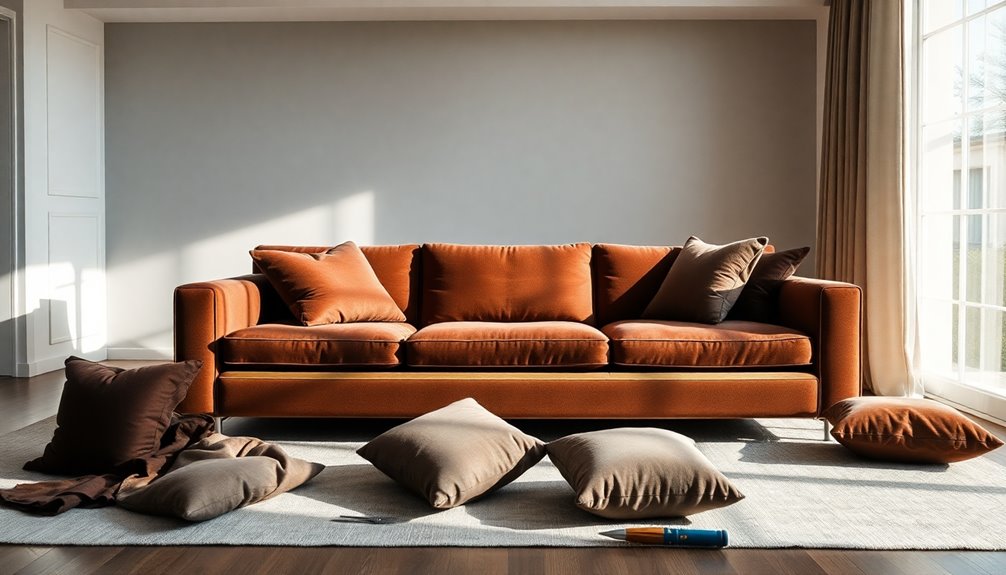
Successfully disconnecting a sectional sofa not only makes storage easier but also helps maintain its condition for future use. When you tackle this task, it's important to remember how the pieces are connected. Start by clearing the area around your sofa to ensure a safe and efficient disconnection process. Lift the pieces at their connection points, checking for sliding pins or snap connectors, depending on your sofa model. If you encounter resistance, try lifting from the opposite side or inspect for misaligned connectors that might need adjustment.
Maintaining a proper technique is vital—always lift straight up rather than sideways to avoid damaging the sofa or its connectors. Once you've successfully disconnected the pieces, don't forget the next step: storing all components, including screws and connectors, in labeled bags. This will make reassembly a breeze when you're ready to set up your sofa again.
Frequently Asked Questions
Can You Detach a Sectional Sofa?
Yes, you can definitely detach a sectional sofa! Start by checking for connectors like sliding pins or snap connectors, usually found at the corners or underneath the pieces. To separate them, lift one side near the connection; if it comes apart, continue lifting to fully disconnect. Make sure you have a clear space around the sofa, and remember to lift with care, as the sections can be heavy. Regular maintenance helps, too!
How to Remove a Couch by Yourself?
To remove a couch by yourself, start by clearing the area around it to avoid tripping over anything. Take off all cushions and, if applicable, unscrew the legs to lighten the load. Use furniture sliders under the feet for easier movement. When it's time to lift, bend at your knees and keep your back straight. Carefully maneuver the couch out, making sure to take your time and avoid any damage to walls or floors.
How to Break Down a Sofa for the Dump?
To break down a sofa for the dump, start by removing the cushions and seat covers. You’ll want to lighten it up for easier handling. Next, grab your tools—like a Phillips head screwdriver and Allen wrench—to detach the legs and arms. Don’t forget to remove any connectors holding the frame together. Once disassembled, wrap the pieces to prevent damage during transport, and check local regulations for proper disposal methods. After wrapping the individual parts, you should also consider ways to repurpose or recycle any materials, such as fabric and wood, to minimize waste. Before you head to the dump, it’s crucial to research how to properly dispose of a sofa, as some areas have specific guidelines or designated drop-off locations for large furniture. By following these steps, you can ensure that the sofa is not only broken down safely but also disposed of in an environmentally friendly manner.
How to Dismantle a Sofa to Fit Through a Door?
To dismantle a sofa for fitting through a door, start by measuring both the sofa and the doorway to find the best angle. Remove cushions and any detachable parts like legs. If the sofa has connection points, carefully unscrew or detach them. Grab a helper to assist you with lifting and guiding the piece. You might need to turn the sofa on its side or at an angle to navigate tight spaces safely.
